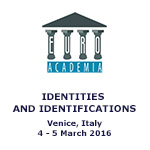Euroacademia Conferences
 Europe Inside-Out: Europe and Europeanness Exposed to Plural Observers (9th Edition) April 24 - 25, 2020
Europe Inside-Out: Europe and Europeanness Exposed to Plural Observers (9th Edition) April 24 - 25, 2020 Identities and Identifications: Politicized Uses of Collective Identities (9th Edition) June 12 - 13, 2020
Identities and Identifications: Politicized Uses of Collective Identities (9th Edition) June 12 - 13, 2020 8th Forum of Critical Studies: Asking Big Questions Again January 24 - 25, 2020
8th Forum of Critical Studies: Asking Big Questions Again January 24 - 25, 2020 Re-Inventing Eastern Europe (7th Edition) December 13 - 14, 2019
Re-Inventing Eastern Europe (7th Edition) December 13 - 14, 2019 The European Union and the Politicization of Europe (8th Edition) October 25 - 26, 2019
The European Union and the Politicization of Europe (8th Edition) October 25 - 26, 2019 Identities and Identifications: Politicized Uses of Collective Identities (8th Edition) June 28 - 29, 2019
Identities and Identifications: Politicized Uses of Collective Identities (8th Edition) June 28 - 29, 2019 The European Union and the Politicization of Europe (7th Edition) January 25 - 26, 2019
The European Union and the Politicization of Europe (7th Edition) January 25 - 26, 2019 7th Forum of Critical Studies: Asking Big Questions Again November 23 - 24, 2018
7th Forum of Critical Studies: Asking Big Questions Again November 23 - 24, 2018 Europe Inside-Out: Europe and Europeanness Exposed to Plural Observers (8th Edition) September 28 - 30, 2018
Europe Inside-Out: Europe and Europeanness Exposed to Plural Observers (8th Edition) September 28 - 30, 2018 Identities and Identifications: Politicized Uses of Collective Identities (7th Edition) June 14 - 15, 2018
Identities and Identifications: Politicized Uses of Collective Identities (7th Edition) June 14 - 15, 2018
Contemporary Japanese Arts: National Identity Making Within the Representations of Nature
-
-

-
Presentation speakers
- Jutta Teuwsen, Heinrich Heine University Düsseldorf, Germany
- Download presentation
Abstract:
The intense and extraordinary relationship to nature is held as one crucial cultural value of the Japanese. This picture is constructed and maintained diligently not only by foreigners, but especially by Japanese themselves. Japanese like to speak about themselves as nature-loving people and for foreigners this picture of the nature-bound Japanese serves their expectations well. Notably in the field of representations of nature in contemporary Japanese arts this picture is reproduced and maintained continuously. Today, contemporary Japanese art is undergoing radical change. While artists like Murakami Takashi and Nara Yoshitomo dominated the scene from the late 1990s up to 2010 by blurring the borders between popular culture and so-called high art, after the triple-disaster of Fukushima, 2011, the wind has changed. In arts, no longer the cool and the cute construct the pillars of national identity, but representations of nature. This paper will analyze and explain, how artists through representations of nature construct the Japanese national identity. Upon that, it will give an outlook about the relevance of reproducing these pictures of a Japanese national identity for marketing Japanese arts nationally and internationally today.
-
Related Presentations

Borders Objects: Dissolution or Exacerbation of Identity
- Sabine Du Crest

The Gendered Sense of Self: Performing Identities Within Biographical Narratives
- Noemi Basanta Llanes













